计算机视觉+人体姿态识别+双目视觉
《基于双目立体视觉定位和识别技术的研究》范文

《基于双目立体视觉定位和识别技术的研究》篇一一、引言随着科技的飞速发展,计算机视觉技术在各个领域得到了广泛的应用。
其中,双目立体视觉定位和识别技术作为计算机视觉的重要分支,其研究具有重要的理论价值和应用前景。
本文旨在探讨基于双目立体视觉定位和识别技术的研究,分析其原理、方法及在各个领域的应用,以期为相关研究提供参考。
二、双目立体视觉定位和识别技术原理双目立体视觉定位和识别技术是通过模拟人类双眼的视觉系统,利用两个相机从不同角度获取同一场景的图像信息,通过对两幅图像进行匹配、计算和重建,从而实现三维空间的定位和识别。
其原理主要包括图像获取、图像预处理、特征提取、立体匹配、三维重建等步骤。
三、双目立体视觉定位和识别技术方法1. 图像获取与预处理:通过两个相机从不同角度获取同一场景的图像信息,并进行去噪、灰度化、二值化等预处理操作,以便进行后续的特征提取和匹配。
2. 特征提取:通过算法从预处理后的图像中提取出有意义的特征,如边缘、角点、纹理等。
这些特征将用于后续的立体匹配和三维重建。
3. 立体匹配:利用特征提取的结果,通过立体匹配算法对两幅图像进行匹配,得到视差图。
视差图反映了同一场景在不同视角下的差异,是三维重建的关键信息。
4. 三维重建:根据视差图和相机参数,通过三维重建算法计算出场景中物体的三维坐标信息,实现空间的定位和识别。
四、双目立体视觉定位和识别技术的应用双目立体视觉定位和识别技术在各个领域都有广泛的应用。
在工业领域,可用于机器人导航、物体检测、质量检测等;在医疗领域,可用于三维重建、医学影像处理等;在安防领域,可用于人脸识别、目标跟踪等。
此外,双目立体视觉技术还可应用于无人驾驶、虚拟现实等领域。
五、研究展望随着计算机视觉技术的不断发展,双目立体视觉定位和识别技术将有更广泛的应用前景。
未来研究可关注以下几个方面:一是提高算法的精度和效率,以满足更高精度的应用需求;二是研究更高效的特征提取和匹配算法,以提高立体匹配的准确性和鲁棒性;三是将双目立体视觉技术与深度学习等其他技术相结合,以实现更复杂的任务;四是进一步拓展双目立体视觉技术的应用领域,如无人驾驶、虚拟现实等。
双目立体视觉技术的实现

双目立体视觉技术的实现双目立体视觉技术是指利用两个摄像机模拟人眼双目视觉,从而实现对物体的立体感知和深度信息的提取。
它已经广泛应用于计算机视觉、机器人视觉、虚拟现实、医学影像等领域。
本文将对双目立体视觉技术的实现进行详细介绍。
一、双目视觉原理人类双目视觉的原理是指两只眼睛在不同的位置观察同一物体,从而产生两个稍微不同的图像。
人脑通过类似于计算机中的算法,对两个图像进行计算,从而提取出立体信息,进而对物体进行深度和空间感知。
二、双目立体视觉技术的实现过程1.摄像机的标定由于摄像机内外参数不同,因此在使用双目立体视觉技术时需要先进行摄像机标定。
摄像机标定的过程包括对摄像机的内部参数和外部参数进行测量和计算。
内部参数包括焦距、主点以及径向和切向畸变等,外部参数包括相机的位置和朝向。
通过标定,可以得到摄像机的参数,进而进行后续的处理。
2.图像匹配图像匹配是双目立体视觉技术中最重要的步骤之一,也是最具挑战性的部分。
图像匹配的目的是找到两张图像中对应的像素点。
常用的图像匹配算法包括基于区域、基于特征和基于深度等。
3.深度计算深度计算是指根据匹配到的像素点,计算出物体的距离,即深度。
常用的深度计算方法包括三角测量法和基于视差的深度计算法。
三角测量法是指根据两个图像中对应像素点的位置关系,通过三角形相似原理计算出物体的距离。
基于视差的深度计算法是指通过计算两幅图像中对应点之间的视差(即两个像素在图像上的水平或垂直距离),从而得出物体到相机的距离。
三、双目立体视觉技术的应用1.计算机视觉双目立体视觉技术在计算机视觉领域中已经被广泛应用。
例如,在物体识别、位姿估计以及场景重建等方面,双目立体视觉技术都有重要的应用。
通过双目视觉,计算机可以更加准确地识别图像中的物体,进而进行自动化的控制和处理。
2.机器人视觉机器人视觉是指将双目视觉技术应用于机器人的感知和控制。
例如,在自主导航、抓取和操纵等方面,机器人需要通过视觉来获取场景信息和深度信息,从而实现自主决策和控制。
《2024年度基于双目立体视觉定位和识别技术的研究》范文

《基于双目立体视觉定位和识别技术的研究》篇一一、引言随着科技的飞速发展,计算机视觉技术在许多领域中得到了广泛的应用。
其中,双目立体视觉定位和识别技术以其高精度、高效率的特点,在机器人导航、工业检测、无人驾驶等领域展现出巨大的应用潜力。
本文将围绕双目立体视觉定位和识别技术进行深入的研究和探讨。
二、双目立体视觉技术概述双目立体视觉技术是一种模拟人类双眼视觉的计算机视觉技术。
通过模拟人眼的视差感知原理,双目立体视觉技术利用两个相机从不同角度获取场景的图像信息,然后通过图像处理和算法分析,得到场景中物体的三维信息。
双目立体视觉技术主要包括相机标定、图像获取、图像预处理、特征提取、立体匹配、三维重建等步骤。
三、双目立体视觉定位技术双目立体视觉定位技术是双目立体视觉技术的核心部分,它通过计算左右相机获取的图像间的视差信息,实现场景中物体的三维定位。
具体而言,双目立体视觉定位技术首先需要对相机进行精确的标定,以获取相机的内外参数。
然后通过图像预处理和特征提取,获取场景中的特征点或特征线。
接着,利用立体匹配算法,将左右相机获取的图像进行匹配,得到视差图。
最后,根据视差信息和相机的内外参数,计算得到场景中物体的三维坐标信息。
四、双目立体视觉识别技术双目立体视觉识别技术是在定位技术的基础上,进一步对场景中的物体进行分类和识别。
通过分析物体的形状、大小、纹理等特征信息,结合机器学习、深度学习等算法,实现对物体的识别和分类。
双目立体视觉识别技术可以广泛应用于无人驾驶、机器人导航、工业检测等领域。
五、双目立体视觉技术的应用双目立体视觉技术在许多领域都得到了广泛的应用。
在无人驾驶领域,双目立体视觉技术可以实现车辆的定位和障碍物识别,提高车辆的行驶安全性和自动驾驶的准确性。
在机器人导航领域,双目立体视觉技术可以帮助机器人实现精准的路径规划和导航。
在工业检测领域,双目立体视觉技术可以实现对产品的快速检测和质量控制。
六、研究展望随着计算机视觉技术的不断发展,双目立体视觉定位和识别技术将会有更广泛的应用前景。
计算机双目视觉系统设计及其应用
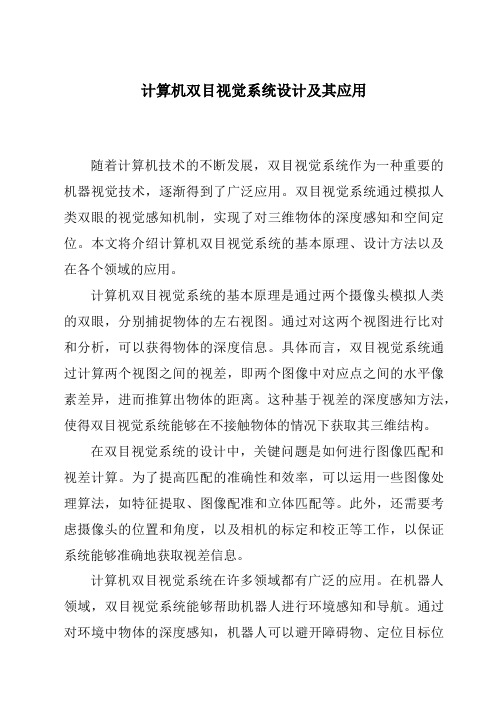
计算机双目视觉系统设计及其应用随着计算机技术的不断发展,双目视觉系统作为一种重要的机器视觉技术,逐渐得到了广泛应用。
双目视觉系统通过模拟人类双眼的视觉感知机制,实现了对三维物体的深度感知和空间定位。
本文将介绍计算机双目视觉系统的基本原理、设计方法以及在各个领域的应用。
计算机双目视觉系统的基本原理是通过两个摄像头模拟人类的双眼,分别捕捉物体的左右视图。
通过对这两个视图进行比对和分析,可以获得物体的深度信息。
具体而言,双目视觉系统通过计算两个视图之间的视差,即两个图像中对应点之间的水平像素差异,进而推算出物体的距离。
这种基于视差的深度感知方法,使得双目视觉系统能够在不接触物体的情况下获取其三维结构。
在双目视觉系统的设计中,关键问题是如何进行图像匹配和视差计算。
为了提高匹配的准确性和效率,可以运用一些图像处理算法,如特征提取、图像配准和立体匹配等。
此外,还需要考虑摄像头的位置和角度,以及相机的标定和校正等工作,以保证系统能够准确地获取视差信息。
计算机双目视觉系统在许多领域都有广泛的应用。
在机器人领域,双目视觉系统能够帮助机器人进行环境感知和导航。
通过对环境中物体的深度感知,机器人可以避开障碍物、定位目标位置等。
在工业制造中,双目视觉系统可以应用于产品质量检测、零件定位和装配等任务。
在医疗领域,双目视觉系统可以辅助医生进行手术操作、病理诊断等。
总之,计算机双目视觉系统是一种重要的机器视觉技术,具有广泛的应用前景。
通过模拟人类双眼的视觉感知机制,该系统可以实现对物体的深度感知和空间定位。
在设计中,需要考虑图像匹配和视差计算等关键问题。
在应用中,双目视觉系统可以帮助机器人进行环境感知和导航,用于工业制造中的质量检测和装配,以及在医疗领域的手术操作和病理诊断等。
随着技术的不断发展,计算机双目视觉系统将在更多领域发挥重要作用。
《2024年基于计算机立体视觉的双目立体成像研究》范文
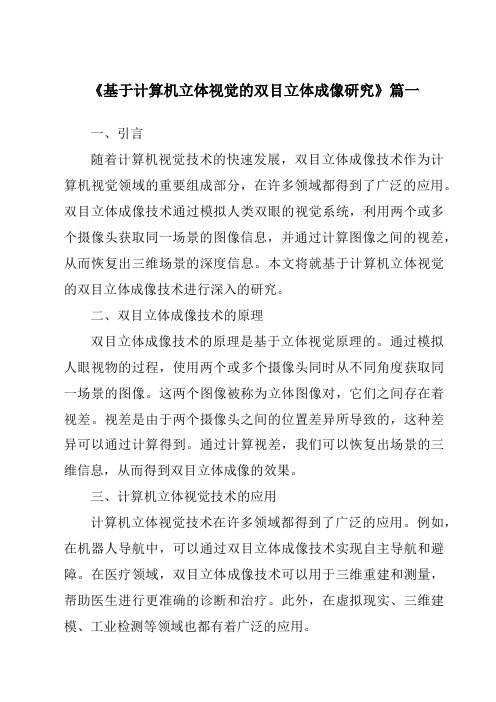
《基于计算机立体视觉的双目立体成像研究》篇一一、引言随着计算机视觉技术的快速发展,双目立体成像技术作为计算机视觉领域的重要组成部分,在许多领域都得到了广泛的应用。
双目立体成像技术通过模拟人类双眼的视觉系统,利用两个或多个摄像头获取同一场景的图像信息,并通过计算图像之间的视差,从而恢复出三维场景的深度信息。
本文将就基于计算机立体视觉的双目立体成像技术进行深入的研究。
二、双目立体成像技术的原理双目立体成像技术的原理是基于立体视觉原理的。
通过模拟人眼视物的过程,使用两个或多个摄像头同时从不同角度获取同一场景的图像。
这两个图像被称为立体图像对,它们之间存在着视差。
视差是由于两个摄像头之间的位置差异所导致的,这种差异可以通过计算得到。
通过计算视差,我们可以恢复出场景的三维信息,从而得到双目立体成像的效果。
三、计算机立体视觉技术的应用计算机立体视觉技术在许多领域都得到了广泛的应用。
例如,在机器人导航中,可以通过双目立体成像技术实现自主导航和避障。
在医疗领域,双目立体成像技术可以用于三维重建和测量,帮助医生进行更准确的诊断和治疗。
此外,在虚拟现实、三维建模、工业检测等领域也都有着广泛的应用。
四、双目立体成像技术的实现方法双目立体成像技术的实现方法主要包括图像获取、图像预处理、特征提取、视差计算和三维重建等步骤。
首先,通过两个或多个摄像头获取同一场景的图像对。
然后,对图像进行预处理,包括去噪、灰度化等操作。
接着,提取图像中的特征信息,如边缘、角点等。
然后,通过计算视差,得到每个像素点的深度信息。
最后,根据深度信息恢复出三维场景的深度信息,实现双目立体成像的效果。
五、基于计算机立体视觉的双目立体成像技术的优势与挑战优势:1. 高精度:双目立体成像技术可以获得较高的三维重建精度。
2. 实时性:随着计算机技术的不断发展,双目立体成像技术的实时性得到了很大的提高。
3. 广泛应用:双目立体成像技术在许多领域都有着广泛的应用前景。
人脸识别双目解决方案(3篇)

第1篇随着科技的不断发展,人脸识别技术逐渐成为人工智能领域的研究热点。
双目视觉技术作为人脸识别的重要手段,通过模拟人类视觉系统,实现了高精度、高效率的人脸识别。
本文将详细介绍人脸识别双目解决方案,包括系统架构、关键技术、应用场景及未来发展。
一、系统架构人脸识别双目解决方案主要由以下几部分组成:1. 摄像头:用于采集人脸图像,是整个系统的数据输入端。
根据应用场景,可以选择不同焦距、分辨率和光圈的摄像头。
2. 预处理模块:对采集到的人脸图像进行预处理,包括去噪、灰度化、二值化、边缘检测等,以提高后续处理的准确率。
3. 特征提取模块:从预处理后的人脸图像中提取关键特征,如纹理、形状、纹理形状结合等。
常用的特征提取方法有SIFT、SURF、HOG、LBP等。
4. 特征匹配模块:将提取的特征与数据库中的人脸特征进行匹配,找出相似度最高的人脸。
常用的匹配方法有FLANN、Brute-Force等。
5. 人脸识别模块:根据特征匹配结果,判断是否为人脸识别成功。
通常采用阈值法或相似度评分法进行判断。
6. 后处理模块:对人脸识别结果进行输出,如显示识别结果、语音提示等。
二、关键技术1. 双目视觉技术双目视觉技术是通过两个摄像头分别采集人脸图像,通过计算两个图像之间的视差,从而实现对三维空间中人脸位置的估计。
双目视觉技术具有以下优点:(1)高精度:双目视觉技术能够准确获取人脸的三维信息,提高识别精度。
(2)抗干扰能力强:双目视觉技术能够有效抵御光照、角度等因素的影响。
(3)实时性好:双目视觉技术具有实时性,能够满足实时人脸识别的需求。
2. 特征提取与匹配特征提取与匹配是人脸识别的核心技术。
以下介绍几种常用的特征提取与匹配方法:(1)SIFT(尺度不变特征变换):SIFT算法通过检测关键点,提取关键点坐标、方向和尺度,从而实现特征提取。
SIFT算法具有鲁棒性强、抗干扰能力强等优点。
(2)SURF(加速稳健特征):SURF算法基于SIFT算法,进一步提高了特征提取的速度。
基于双目视觉的相对物体的姿态测量
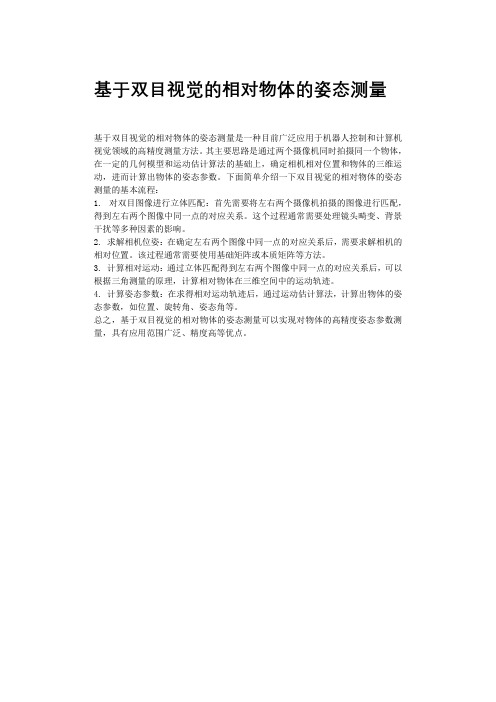
基于双目视觉的相对物体的姿态测量
基于双目视觉的相对物体的姿态测量是一种目前广泛应用于机器人控制和计算机视觉领域的高精度测量方法。
其主要思路是通过两个摄像机同时拍摄同一个物体,在一定的几何模型和运动估计算法的基础上,确定相机相对位置和物体的三维运动,进而计算出物体的姿态参数。
下面简单介绍一下双目视觉的相对物体的姿态测量的基本流程:
1. 对双目图像进行立体匹配:首先需要将左右两个摄像机拍摄的图像进行匹配,得到左右两个图像中同一点的对应关系。
这个过程通常需要处理镜头畸变、背景干扰等多种因素的影响。
2. 求解相机位姿:在确定左右两个图像中同一点的对应关系后,需要求解相机的相对位置。
该过程通常需要使用基础矩阵或本质矩阵等方法。
3. 计算相对运动:通过立体匹配得到左右两个图像中同一点的对应关系后,可以根据三角测量的原理,计算相对物体在三维空间中的运动轨迹。
4. 计算姿态参数:在求得相对运动轨迹后,通过运动估计算法,计算出物体的姿态参数,如位置、旋转角、姿态角等。
总之,基于双目视觉的相对物体的姿态测量可以实现对物体的高精度姿态参数测量,具有应用范围广泛、精度高等优点。
如何利用计算机视觉技术进行人体姿态识别与分析

如何利用计算机视觉技术进行人体姿态识别与分析近年来,随着计算机视觉技术的快速发展,人体姿态识别与分析在各个领域得到了广泛应用。
人体姿态识别与分析是指利用计算机视觉技术对人体姿态进行自动识别和分析的过程。
它可以帮助我们更好地理解人类行为,提供智能监控、安防、人机交互等方面的支持。
首先,人体姿态识别与分析需要使用图像或视频作为输入。
这些图像或视频可以通过摄像头或其他传感设备捕捉到,然后通过计算机视觉算法进行处理。
其中最常用的算法是基于深度学习的方法,如卷积神经网络(CNN)和循环神经网络(RNN)等。
这些算法能够从图像中提取出人体的关键点位置,进而确定人体的姿态。
其次,人体姿态识别与分析主要包括两个方面:姿态识别和姿态分析。
姿态识别是指根据输入的图像或视频判断人体的姿态,通常使用分类算法进行判断,例如支持向量机(SVM)和决策树等。
而姿态分析则是对已经识别出的姿态进行进一步的分析,例如判断人体是否处于正常姿态、人体的动作是否合理等。
在实际应用中,人体姿态识别与分析可以有多种用途。
首先,它可以应用于智能监控系统中。
通过对监控视频中的人体姿态进行识别和分析,可以自动判断出异常行为,例如摔倒、持械等,从而有效提升监控系统的效果。
其次,人体姿态识别与分析可以应用于安防系统中。
通过对入侵者的姿态进行分析,可以判断其是否具有攻击性,从而提前采取相应的安全措施。
此外,人体姿态识别与分析还可以用于人机交互领域。
通过对用户的姿态进行识别,可以实现自然的人机交互,例如通过手势控制智能设备。
但是,人体姿态识别与分析也面临一些挑战。
首先,由于人体姿态的多样性,算法需要具备较强的泛化能力。
其次,在复杂背景下的人体姿态识别和分析相对困难,需要对算法进行进一步的改进。
此外,对于实时应用场景,算法的速度也是一个考虑因素。
为了提高人体姿态识别与分析的效果,可以采取以下策略。
首先,收集更多的样本数据,包括不同人体姿态、不同背景等,从而提高算法的泛化能力。
《2024年基于计算机立体视觉的双目立体成像研究》范文
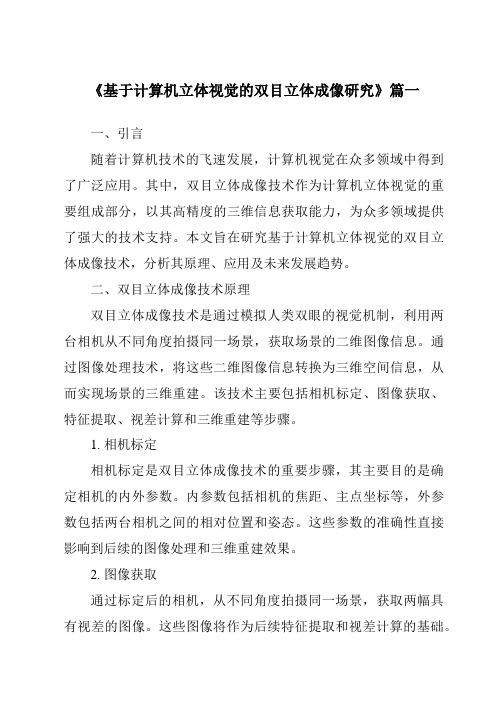
《基于计算机立体视觉的双目立体成像研究》篇一一、引言随着计算机技术的飞速发展,计算机视觉在众多领域中得到了广泛应用。
其中,双目立体成像技术作为计算机立体视觉的重要组成部分,以其高精度的三维信息获取能力,为众多领域提供了强大的技术支持。
本文旨在研究基于计算机立体视觉的双目立体成像技术,分析其原理、应用及未来发展趋势。
二、双目立体成像技术原理双目立体成像技术是通过模拟人类双眼的视觉机制,利用两台相机从不同角度拍摄同一场景,获取场景的二维图像信息。
通过图像处理技术,将这些二维图像信息转换为三维空间信息,从而实现场景的三维重建。
该技术主要包括相机标定、图像获取、特征提取、视差计算和三维重建等步骤。
1. 相机标定相机标定是双目立体成像技术的重要步骤,其主要目的是确定相机的内外参数。
内参数包括相机的焦距、主点坐标等,外参数包括两台相机之间的相对位置和姿态。
这些参数的准确性直接影响到后续的图像处理和三维重建效果。
2. 图像获取通过标定后的相机,从不同角度拍摄同一场景,获取两幅具有视差的图像。
这些图像将作为后续特征提取和视差计算的基础。
3. 特征提取特征提取是双目立体成像技术的关键步骤,其主要目的是从两幅具有视差的图像中提取出具有匹配性的特征点。
这些特征点将用于后续的视差计算和三维重建。
4. 视差计算视差计算是通过比较两幅图像中相同特征点的位置差异,计算视差信息的过程。
视差信息反映了场景中物体在三维空间中的位置和距离信息。
5. 三维重建根据视差信息和相机的内外参数,通过三角测量原理,可以实现对场景的三维重建。
三维重建后的场景信息可以用于后续的目标检测、识别和跟踪等任务。
三、双目立体成像技术的应用双目立体成像技术具有广泛的应用前景,包括机器人导航、三维测量、虚拟现实、医学影像等领域。
1. 机器人导航双目立体成像技术可以为机器人提供精确的三维环境信息,实现机器人的自主导航和避障功能。
在无人驾驶汽车、无人机等领域具有广泛的应用前景。
基于双目摄像头的人体姿态识别研究

基于双目摄像头的人体姿态识别研究近年来,在计算机视觉领域,人体姿态识别技术得到了广泛的研究和应用。
而基于双目摄像头的人体姿态识别系统,因为具备更多维度的信息,尤其在深度推断、骨骼追踪等领域具有优越性,是近年来备受关注的新技术。
一、双目摄像头人体姿态识别系统的原理基于双目摄像头的人体姿态识别,主要基于计算机视觉中的双目视觉原理。
在形成人眼视觉的过程中,左右眼观察到的同一个物体场景会有些微差异,这种微差异叫做视差。
将这两个不同角度拍摄到的图像纹理进行对应,就可获得物体三维坐标和深度信息。
如下图所示:一个人同一个场景在两个不同摄像头的视角下观察产生微差距,通过视差测量实现深度感知。
基于双目摄像头的人体姿态识别利用这种原理,将不同角度下的人体信息处理为三维信息,再通过比对人体姿态识别库中的模板,快速准确地对人体姿态进行识别。
二、双目摄像头人体姿态识别技术的应用1. 人机交互领域基于双目摄像头的人体姿态识别技术,可以实现快速、便捷的人机交互交互方式。
用户只需在摄像头前进行各种动作、手势、动作等操作,系统可以实时识别用户动作,自动响应相关功能。
比如,在某些公共场合,利用双目摄像头人体姿态识别技术可以实现各种操作。
例如,在商场内安放双目摄像头检测台,当消费者走到检测台前,摄像头将自动捕捉消费者的体态、手势、面部表情、年龄、性别等信息,根据消费者的性别、年龄和购买记录等信息,自动生成不同的广告、产品推荐等信息,极大地提高了市场促销效果和用户体验。
2. 医疗保健领域在医疗保健领域,基于双目摄像头的人体姿态识别技术也有着广泛应用空间,如自动化护理、康复治疗、健身操教学等等。
例如,通过监测患者躯干前屈后伸等基本姿态来评估腰背疾病,定期检测老人家庭颈椎保健、预防颈肩病、腰部按摩机等产品;通过姿态解析技术,对患者做出高精度的康复治疗计划,大幅提高治疗效果。
3. 安防监控领域在安防领域,基于双目摄像头的人体姿态识别技术可以应用于目标检测、行为分析、人脸识别等多个方面,提高视频监控、安全防范、实时预警监控等领域的质量和效率。
双目人脸识别原理

双目人脸识别原理双目人脸识别是一种基于双目立体视觉原理的人脸识别技术,通过模拟人眼的视觉原理,利用两个相机从不同角度拍摄同一物体,获取物体在不同位置的图像,再通过计算两个图像中对应点的视差,得到物体的三维信息。
在人脸识别领域,双目人脸识别技术可以用来获取人脸的深度信息,从而实现对人脸的识别。
具体来说,通过将两个相机放置在不同的位置,拍摄同一人脸的图像,然后通过对两张图像进行处理,得到人脸在不同位置的深度信息。
这些深度信息可以帮助计算机更好地理解人脸的结构和特征,从而实现更加准确的人脸识别。
双目人脸识别技术的核心在于对两张图像中对应点的匹配和深度计算。
具体来说,首先需要通过图像处理算法对两张图像进行预处理,包括图像配准、特征提取和匹配等步骤。
然后,通过计算图像中特征点的视差,得到人脸在不同位置的深度信息。
这些深度信息可以通过三维重建算法进行进一步的处理,从而得到更加准确的人脸模型。
双目人脸识别技术具有以下几个优点:1. 可靠性高:双目人脸识别技术可以获得人脸的深度信息,从而更加准确地识别不同姿态和光照条件下的人脸。
2. 精度高:双目人脸识别技术可以通过计算图像中特征点的视差,得到高精度的深度信息,从而提高人脸识别的准确度。
3. 鲁棒性强:双目人脸识别技术可以适应不同的人脸姿态、光照条件和噪声干扰,具有较强的鲁棒性。
4. 安全性高:双目人脸识别技术可以实现对人脸的全方位识别和监测,可以提高安全性和可靠性。
然而,双目人脸识别技术也存在一些挑战和限制,例如需要精确的相机标定和图像配准算法,对硬件设备的要求较高,同时需要处理大量的图像数据,对计算资源的消耗较大。
此外,双目人脸识别技术对于不同材质、纹理和形状的物体识别效果可能存在差异。
使用计算机视觉技术进行人体姿态识别的方法

使用计算机视觉技术进行人体姿态识别的方法人体姿态识别是计算机视觉技术中的一个重要研究领域,旨在通过计算机对人体姿态进行自动识别和分析。
这项技术可以应用于很多领域,如健康监测、智能安防、虚拟现实等。
本文将介绍一些使用计算机视觉技术进行人体姿态识别的方法。
首先,人体姿态识别的方法主要可以分为两种:基于传感器的方法和基于图像的方法。
基于传感器的方法使用传感器设备,如惯性测量单元(IMU)或深度摄像头等,通过收集人体姿态相关数据来进行识别。
而基于图像的方法使用计算机视觉技术对图像或视频中的人体进行分析和识别。
基于传感器的方法常用的设备是惯性测量单元(IMU)。
IMU可以测量人体的加速度、角速度和方向等信息,通过这些信息可以计算出人体的姿态。
这种方法不受环境光线影响,适用于室内和室外环境。
然而,由于IMU的数据有噪音和漂移等问题,需要进行滤波和姿态优化等处理,以提高精度和稳定性。
基于图像的方法是比较常见和广泛应用的方式之一。
它可以使用普通的RGB 摄像头或深度摄像头来捕捉人体的图像或深度图像。
然后,通过对图像进行处理和分析,提取人体关键点或姿态特征,并通过机器学习算法进行分类和识别。
常见的图像处理技术包括边缘检测、人体轮廓提取、关键点检测等。
机器学习算法可以是传统的分类器,如支持向量机(SVM),也可以是深度学习算法,如卷积神经网络(CNN)。
在图像姿态识别中,人体关键点检测是一个关键步骤。
关键点是人体的特定位置,例如头部、手臂、腿部等。
检测这些关键点可以帮助分析人体的姿态和动作。
一种常用的方法是基于卷积神经网络的关键点检测方法。
它使用标注好的训练数据对网络进行训练,学习人体关键点的位置信息,并在测试阶段对输入图像进行关键点检测和识别。
除了关键点检测,姿态估计也是人体姿态识别的一个重要任务。
姿态估计旨在推测人体姿态的三维结构,包括关节的旋转角度和位置。
传统的方法使用了特征描述符和模型匹配等技术,但这些方法在复杂场景下容易受到干扰。
双目视觉方案
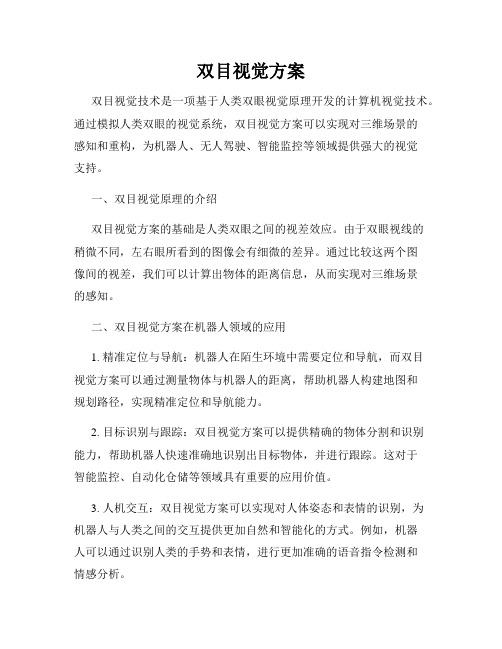
双目视觉方案双目视觉技术是一项基于人类双眼视觉原理开发的计算机视觉技术。
通过模拟人类双眼的视觉系统,双目视觉方案可以实现对三维场景的感知和重构,为机器人、无人驾驶、智能监控等领域提供强大的视觉支持。
一、双目视觉原理的介绍双目视觉方案的基础是人类双眼之间的视差效应。
由于双眼视线的稍微不同,左右眼所看到的图像会有细微的差异。
通过比较这两个图像间的视差,我们可以计算出物体的距离信息,从而实现对三维场景的感知。
二、双目视觉方案在机器人领域的应用1. 精准定位与导航:机器人在陌生环境中需要定位和导航,而双目视觉方案可以通过测量物体与机器人的距离,帮助机器人构建地图和规划路径,实现精准定位和导航能力。
2. 目标识别与跟踪:双目视觉方案可以提供精确的物体分割和识别能力,帮助机器人快速准确地识别出目标物体,并进行跟踪。
这对于智能监控、自动化仓储等领域具有重要的应用价值。
3. 人机交互:双目视觉方案可以实现对人体姿态和表情的识别,为机器人与人类之间的交互提供更加自然和智能化的方式。
例如,机器人可以通过识别人类的手势和表情,进行更加准确的语音指令检测和情感分析。
三、双目视觉方案在无人驾驶领域的应用1. 环境感知与障碍物检测:无人驾驶汽车需要实时感知道路环境并识别障碍物,而双目视觉方案可以提供高分辨率的深度图像信息,帮助车辆准确地感知和判别道路上的物体,并做出相应的驾驶决策。
2. 路面识别与车道保持:双目视觉方案可以识别道路的纹理和标线,辅助车辆准确定位和车道保持。
通过与车载传感器的数据融合,可以实现高精度和鲁棒性的自动驾驶功能。
3. 防碰撞与智能避障:基于双目视觉方案的深度信息,无人驾驶汽车可以实时监测和预测周围环境中的障碍物,并做出适时的避障决策。
这样可以提高车辆的安全性和驾驶效果。
四、双目视觉方案的发展和前景当前,双目视觉方案在各个领域已经得到广泛的应用,然而仍存在一些挑战,如计算复杂度高、对环境光照敏感等。
随着计算机硬件和算法的不断发展,双目视觉方案有望在未来取得更大的突破,并实现更广泛的应用。
《2024年基于双目立体视觉定位和识别技术的研究》范文
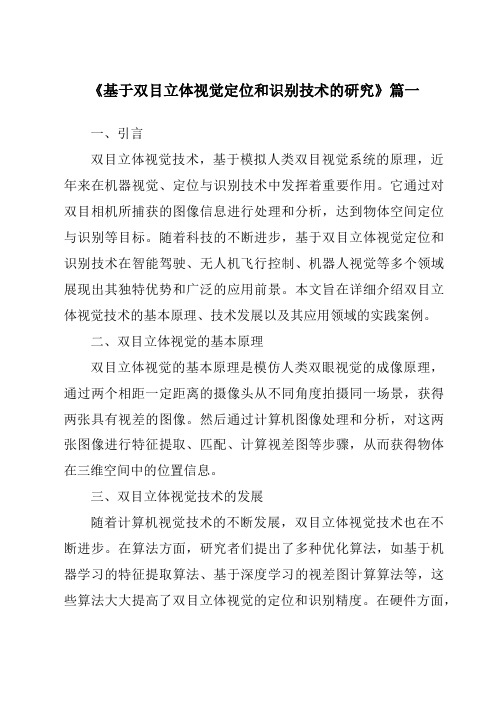
《基于双目立体视觉定位和识别技术的研究》篇一一、引言双目立体视觉技术,基于模拟人类双目视觉系统的原理,近年来在机器视觉、定位与识别技术中发挥着重要作用。
它通过对双目相机所捕获的图像信息进行处理和分析,达到物体空间定位与识别等目标。
随着科技的不断进步,基于双目立体视觉定位和识别技术在智能驾驶、无人机飞行控制、机器人视觉等多个领域展现出其独特优势和广泛的应用前景。
本文旨在详细介绍双目立体视觉技术的基本原理、技术发展以及其应用领域的实践案例。
二、双目立体视觉的基本原理双目立体视觉的基本原理是模仿人类双眼视觉的成像原理,通过两个相距一定距离的摄像头从不同角度拍摄同一场景,获得两张具有视差的图像。
然后通过计算机图像处理和分析,对这两张图像进行特征提取、匹配、计算视差图等步骤,从而获得物体在三维空间中的位置信息。
三、双目立体视觉技术的发展随着计算机视觉技术的不断发展,双目立体视觉技术也在不断进步。
在算法方面,研究者们提出了多种优化算法,如基于机器学习的特征提取算法、基于深度学习的视差图计算算法等,这些算法大大提高了双目立体视觉的定位和识别精度。
在硬件方面,随着双目相机的不断发展和普及,其性能和成像质量也在不断提高。
四、双目立体视觉的应用领域1. 智能驾驶:在智能驾驶领域,双目立体视觉技术被广泛应用于车辆环境感知系统。
通过双目相机对道路环境进行实时监测和识别,可以实现对车辆周围物体的定位和距离测量,为自动驾驶提供重要的决策依据。
2. 无人机飞行控制:在无人机飞行控制中,双目立体视觉技术可以帮助无人机实现精准的定位和避障功能。
通过双目相机对周围环境进行实时监测和识别,无人机可以自动规划飞行路径并避开障碍物。
3. 机器人视觉:在机器人视觉领域,双目立体视觉技术可以帮助机器人实现三维空间定位和物体识别功能。
这对于机器人进行复杂任务操作具有重要意义。
五、实践案例分析以智能驾驶为例,介绍双目立体视觉技术的应用。
在智能驾驶系统中,双目相机被安装在车辆的前部,对道路环境进行实时监测。
《2024年基于双目立体视觉定位和识别技术的研究》范文
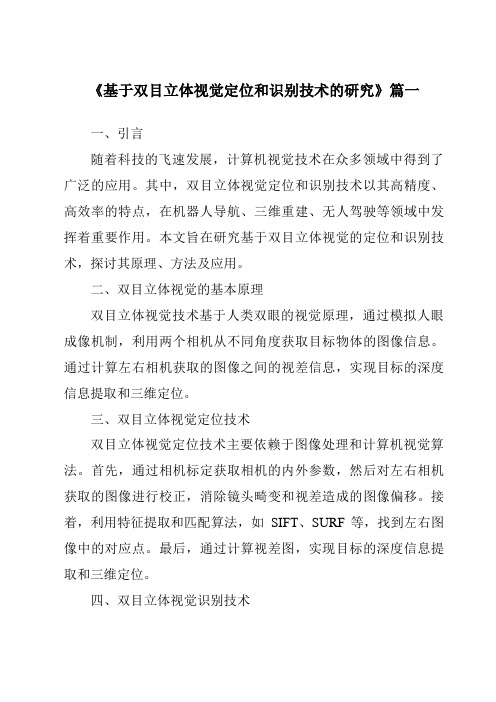
《基于双目立体视觉定位和识别技术的研究》篇一一、引言随着科技的飞速发展,计算机视觉技术在众多领域中得到了广泛的应用。
其中,双目立体视觉定位和识别技术以其高精度、高效率的特点,在机器人导航、三维重建、无人驾驶等领域中发挥着重要作用。
本文旨在研究基于双目立体视觉的定位和识别技术,探讨其原理、方法及应用。
二、双目立体视觉的基本原理双目立体视觉技术基于人类双眼的视觉原理,通过模拟人眼成像机制,利用两个相机从不同角度获取目标物体的图像信息。
通过计算左右相机获取的图像之间的视差信息,实现目标的深度信息提取和三维定位。
三、双目立体视觉定位技术双目立体视觉定位技术主要依赖于图像处理和计算机视觉算法。
首先,通过相机标定获取相机的内外参数,然后对左右相机获取的图像进行校正,消除镜头畸变和视差造成的图像偏移。
接着,利用特征提取和匹配算法,如SIFT、SURF等,找到左右图像中的对应点。
最后,通过计算视差图,实现目标的深度信息提取和三维定位。
四、双目立体视觉识别技术双目立体视觉识别技术主要依赖于深度学习和机器学习算法。
首先,通过训练深度学习模型,如卷积神经网络(CNN),实现对目标物体的分类和识别。
然后,结合双目立体视觉定位技术,可以在三维空间中准确地识别目标物体的位置和姿态。
此外,还可以通过多模态融合技术,将双目立体视觉与其他传感器信息进行融合,提高识别的准确性和鲁棒性。
五、应用领域双目立体视觉定位和识别技术在众多领域中有着广泛的应用。
在机器人导航领域,可以通过双目立体视觉实现机器人的自主导航和避障。
在三维重建领域,可以利用双目立体视觉技术对建筑物、地形等进行高精度三维重建。
在无人驾驶领域,双目立体视觉技术可以实现车辆的自主驾驶和障碍物识别。
此外,该技术还广泛应用于医疗、安防、无人机等领域。
六、研究现状与展望目前,双目立体视觉定位和识别技术已经取得了显著的进展。
然而,仍存在一些挑战和问题需要解决。
例如,如何提高算法的鲁棒性和实时性,以适应复杂多变的环境;如何降低系统成本,以便更广泛地应用于各个领域等。
使用计算机视觉技术进行人体姿态估计和动作识别的方法
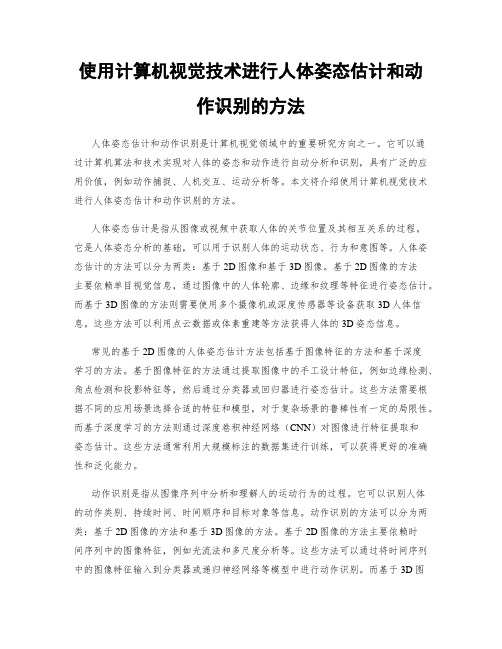
使用计算机视觉技术进行人体姿态估计和动作识别的方法人体姿态估计和动作识别是计算机视觉领域中的重要研究方向之一。
它可以通过计算机算法和技术实现对人体的姿态和动作进行自动分析和识别,具有广泛的应用价值,例如动作捕捉、人机交互、运动分析等。
本文将介绍使用计算机视觉技术进行人体姿态估计和动作识别的方法。
人体姿态估计是指从图像或视频中获取人体的关节位置及其相互关系的过程。
它是人体姿态分析的基础,可以用于识别人体的运动状态、行为和意图等。
人体姿态估计的方法可以分为两类:基于2D图像和基于3D图像。
基于2D图像的方法主要依赖单目视觉信息,通过图像中的人体轮廓、边缘和纹理等特征进行姿态估计。
而基于3D图像的方法则需要使用多个摄像机或深度传感器等设备获取3D人体信息。
这些方法可以利用点云数据或体素重建等方法获得人体的3D姿态信息。
常见的基于2D图像的人体姿态估计方法包括基于图像特征的方法和基于深度学习的方法。
基于图像特征的方法通过提取图像中的手工设计特征,例如边缘检测、角点检测和投影特征等,然后通过分类器或回归器进行姿态估计。
这些方法需要根据不同的应用场景选择合适的特征和模型,对于复杂场景的鲁棒性有一定的局限性。
而基于深度学习的方法则通过深度卷积神经网络(CNN)对图像进行特征提取和姿态估计。
这些方法通常利用大规模标注的数据集进行训练,可以获得更好的准确性和泛化能力。
动作识别是指从图像序列中分析和理解人的运动行为的过程。
它可以识别人体的动作类别、持续时间、时间顺序和目标对象等信息。
动作识别的方法可以分为两类:基于2D图像的方法和基于3D图像的方法。
基于2D图像的方法主要依赖时间序列中的图像特征,例如光流法和多尺度分析等。
这些方法可以通过将时间序列中的图像特征输入到分类器或递归神经网络等模型中进行动作识别。
而基于3D图像的方法则需要利用3D人体姿态信息进行动作识别,例如利用形状描述符和聚类算法进行运动建模和分类。
近年来,随着深度学习技术的快速发展,基于深度学习的人体姿态估计和动作识别方法取得了显著的进展。
《2024年基于计算机立体视觉的双目立体成像研究》范文
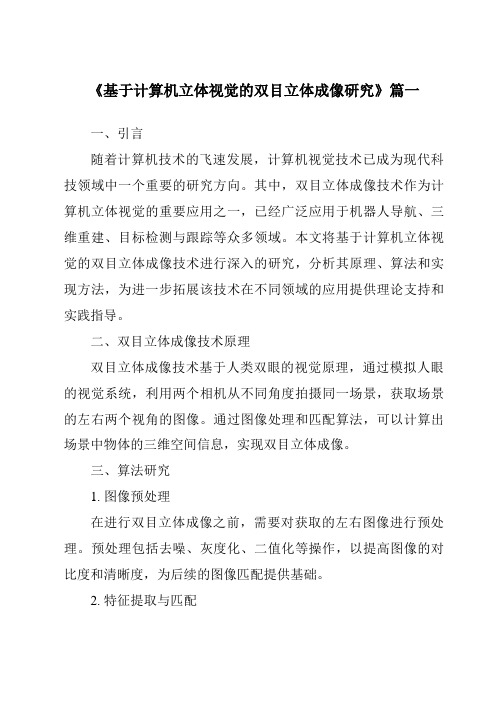
《基于计算机立体视觉的双目立体成像研究》篇一一、引言随着计算机技术的飞速发展,计算机视觉技术已成为现代科技领域中一个重要的研究方向。
其中,双目立体成像技术作为计算机立体视觉的重要应用之一,已经广泛应用于机器人导航、三维重建、目标检测与跟踪等众多领域。
本文将基于计算机立体视觉的双目立体成像技术进行深入的研究,分析其原理、算法和实现方法,为进一步拓展该技术在不同领域的应用提供理论支持和实践指导。
二、双目立体成像技术原理双目立体成像技术基于人类双眼的视觉原理,通过模拟人眼的视觉系统,利用两个相机从不同角度拍摄同一场景,获取场景的左右两个视角的图像。
通过图像处理和匹配算法,可以计算出场景中物体的三维空间信息,实现双目立体成像。
三、算法研究1. 图像预处理在进行双目立体成像之前,需要对获取的左右图像进行预处理。
预处理包括去噪、灰度化、二值化等操作,以提高图像的对比度和清晰度,为后续的图像匹配提供基础。
2. 特征提取与匹配特征提取与匹配是双目立体成像技术的核心步骤。
通过提取左右图像中的特征点,如角点、边缘等,然后利用匹配算法(如SIFT、SURF等)进行特征点的匹配。
匹配后的特征点将作为后续计算三维空间信息的基础。
3. 三维空间信息计算根据匹配后的特征点,利用双目立体成像的几何关系和投影原理,计算出场景中物体的三维空间信息。
这个过程需要考虑到相机的内参和外参、畸变校正等因素。
四、实现方法1. 硬件设备实现双目立体成像需要两个相机、镜头、支架等硬件设备。
相机应选用具有较高分辨率和成像质量的型号,以保证获取的图像质量。
镜头需根据实际应用场景进行选择和调整。
为保证双目视场的重合度和精确性,还需要对相机进行精确的标定和校准。
2. 软件实现软件实现部分包括图像处理、特征提取与匹配、三维空间信息计算等算法的实现。
可以使用C++、Python等编程语言进行开发,并利用OpenCV等计算机视觉库提供的相关函数和算法进行实现。
双目立体视觉匹配
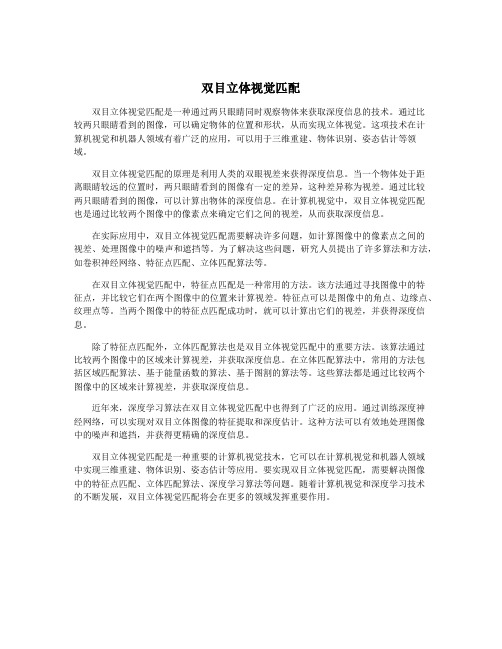
双目立体视觉匹配双目立体视觉匹配是一种通过两只眼睛同时观察物体来获取深度信息的技术。
通过比较两只眼睛看到的图像,可以确定物体的位置和形状,从而实现立体视觉。
这项技术在计算机视觉和机器人领域有着广泛的应用,可以用于三维重建、物体识别、姿态估计等领域。
双目立体视觉匹配的原理是利用人类的双眼视差来获得深度信息。
当一个物体处于距离眼睛较远的位置时,两只眼睛看到的图像有一定的差异,这种差异称为视差。
通过比较两只眼睛看到的图像,可以计算出物体的深度信息。
在计算机视觉中,双目立体视觉匹配也是通过比较两个图像中的像素点来确定它们之间的视差,从而获取深度信息。
在实际应用中,双目立体视觉匹配需要解决许多问题,如计算图像中的像素点之间的视差、处理图像中的噪声和遮挡等。
为了解决这些问题,研究人员提出了许多算法和方法,如卷积神经网络、特征点匹配、立体匹配算法等。
在双目立体视觉匹配中,特征点匹配是一种常用的方法。
该方法通过寻找图像中的特征点,并比较它们在两个图像中的位置来计算视差。
特征点可以是图像中的角点、边缘点、纹理点等。
当两个图像中的特征点匹配成功时,就可以计算出它们的视差,并获得深度信息。
除了特征点匹配外,立体匹配算法也是双目立体视觉匹配中的重要方法。
该算法通过比较两个图像中的区域来计算视差,并获取深度信息。
在立体匹配算法中,常用的方法包括区域匹配算法、基于能量函数的算法、基于图割的算法等。
这些算法都是通过比较两个图像中的区域来计算视差,并获取深度信息。
近年来,深度学习算法在双目立体视觉匹配中也得到了广泛的应用。
通过训练深度神经网络,可以实现对双目立体图像的特征提取和深度估计。
这种方法可以有效地处理图像中的噪声和遮挡,并获得更精确的深度信息。
双目立体视觉匹配是一种重要的计算机视觉技木,它可以在计算机视觉和机器人领域中实现三维重建、物体识别、姿态估计等应用。
要实现双目立体视觉匹配,需要解决图像中的特征点匹配、立体匹配算法、深度学习算法等问题。
双目视觉方案
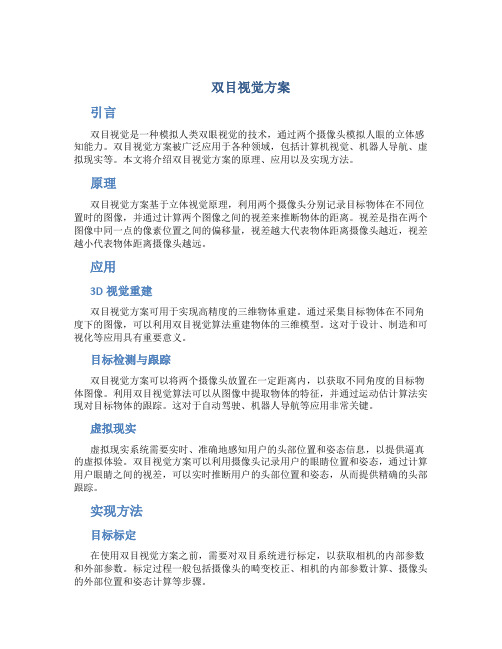
双目视觉方案引言双目视觉是一种模拟人类双眼视觉的技术,通过两个摄像头模拟人眼的立体感知能力。
双目视觉方案被广泛应用于各种领域,包括计算机视觉、机器人导航、虚拟现实等。
本文将介绍双目视觉方案的原理、应用以及实现方法。
原理双目视觉方案基于立体视觉原理,利用两个摄像头分别记录目标物体在不同位置时的图像,并通过计算两个图像之间的视差来推断物体的距离。
视差是指在两个图像中同一点的像素位置之间的偏移量,视差越大代表物体距离摄像头越近,视差越小代表物体距离摄像头越远。
应用3D视觉重建双目视觉方案可用于实现高精度的三维物体重建。
通过采集目标物体在不同角度下的图像,可以利用双目视觉算法重建物体的三维模型。
这对于设计、制造和可视化等应用具有重要意义。
目标检测与跟踪双目视觉方案可以将两个摄像头放置在一定距离内,以获取不同角度的目标物体图像。
利用双目视觉算法可以从图像中提取物体的特征,并通过运动估计算法实现对目标物体的跟踪。
这对于自动驾驶、机器人导航等应用非常关键。
虚拟现实虚拟现实系统需要实时、准确地感知用户的头部位置和姿态信息,以提供逼真的虚拟体验。
双目视觉方案可以利用摄像头记录用户的眼睛位置和姿态,通过计算用户眼睛之间的视差,可以实时推断用户的头部位置和姿态,从而提供精确的头部跟踪。
实现方法目标标定在使用双目视觉方案之前,需要对双目系统进行标定,以获取相机的内部参数和外部参数。
标定过程一般包括摄像头的畸变校正、相机的内部参数计算、摄像头的外部位置和姿态计算等步骤。
视差计算双目视觉的核心算法是视差计算。
通过将两个图像进行匹配,可以计算出每个像素的视差值。
常用的视差计算算法包括基于区域的算法、基于特征点的算法等。
视差图可以通过将视差值映射到灰度图像上进行可视化。
三维重建根据视差图,可以通过三角测量的方法计算出物体的三维坐标。
三角测量可以使用相机的内外参数,将视差值转换为物体的实际距离。
目标检测与跟踪在双目视觉系统中,目标检测与跟踪是一个重要的应用。
- 1、下载文档前请自行甄别文档内容的完整性,平台不提供额外的编辑、内容补充、找答案等附加服务。
- 2、"仅部分预览"的文档,不可在线预览部分如存在完整性等问题,可反馈申请退款(可完整预览的文档不适用该条件!)。
- 3、如文档侵犯您的权益,请联系客服反馈,我们会尽快为您处理(人工客服工作时间:9:00-18:30)。
Computer vision application院(系)电子与信息工程学院专业集成电路工程学生吕广兴14S158054Computer vision applicationThe directoryReport: Computer vision application (2)1.The object of the project (2)2.The method and the principle applied to the project (2)2.1 Platform (2)2.2 The principle of transform the RGB image to the gray image (2)2.3 The principle of image enhancement (2)2.4 The principle of thresholding (3)2.5 The principle of classifier (3)3.The content and the result of the project (4)3.1 The main steps in the project (4)3.2 About human body posture recognition (4)About three kinds of methods are most common: (4)3.3.Stereo vision (11)4.Reference (18)Report: Computer vision application1.The object of the projectThe object of the project is Gesture recognition and location in the interior of people.2.The method and the principle applied to the project2.1 PlatformThe platform is based on Visual Studio 2012 and OpenCV 2.4.10.2.2 The principle of transform the RGB image to the gray imageThere are three major methods to transform the RGB image to the gray image.The first one is called the maximum value that is set the value of R, G, and B to the maximum of these three.Gray=R=G=B=max(R, G, B)The second one is called mean value which is set the value of R, G, and B to the mean value of these three.Gray=R=G=B=(R+G+B)/3The third one is called weighted average that is giving different weights to the R, G and B according to the importance or other indicators, and then adding the three parts together. In fact, human’s eye is very high se nsitive to green, then red, last blue.Gray=0.30R+0.59G+0.11B2.3 The principle of image enhancementImage enhancement is the process of making images more useful. There are two broad categories of image enhancement techniques. The first one is spatial domain technique, and it is a direct manipulation of image pixels that includes point processing and neighborhood operations. The second one is frequency domain technique, and it is a manipulation of Fourier transform or wavelet transform of an image.The principle of the median filter is to replace the value of a pixel by the median of the gray levels in the neighborhood of that pixel(the original value of the pixel is included in the computation of the median). It forces the points with distinct gray levels to be more like their neighbors.In addition, we also apply the morphological image processing after smoothing. Morphological image processing (or morphology) describes a range of image processing techniques that deal with the shape (or morphology) of features in an image. The basic ideal of Morphology is to use a special structuring element to measure or extract the corresponding shape or characteristics in the input images for further image analysis and object recognition. The mathematical foundation of morphology is the set theory. There are two basic morphological operations: erosion and dilation.2.4 The principle of thresholdingThresholding is particularly useful for segmentation in which we want to isolate an object of interest from a background. At the same time, thresholding segmentation is usually the first step in any segmentation approach. The blow formula is the basic principle of image segmentation. When the gray level is no bigger than the threshold, we will set the pixel value zero(black). In contrast, when the gray level is bigger than the threshold, we will set the pixel value 255(white).thresholdr thresholdr s ><==,255,0{ When it comes to the threshold, we get the value through the image histograms 2.5 The principle of classifierThe classifier is a algorithm or device that separates objects into different classes. Usually, a classifier consists of three parts. First one is the sensor, for instance, imaging device, fingerprint reader, etc...Second one is feature extractor, for example, edge detector or property descriptor. Third one is classifier which uses the extracted features for decision making or Euclidian distance, or other methods.Features should can be regarded as the descriptors we introduced before. And the feature should be representative and useful for classification.When it comes to the feature space, the set of all possible patterns form the feature vector. Each feature vector is a point in the so-called feature space. Similar objects yield similar measurement results. Nearby points in feature space correspond to similar objects. Distance in feature space is related to similarity. Points that belong to the same class form a cloud in feature space.Divide the data set into a training set and a test set. The performance of a classifier should be assessed by the classification error on an independent test set. This set should not contain objects that are included in the training set. Determine a decision boundary by minimizing the classification error of the training set. Determine the classifier performance by computing the classification error of the test set.3.The content and the result of the project3.1 The main steps in the projectBefore we segment the vessel and classify the vessel, we can find these images afforded are color. So first we should load these pictures into gray images. Because we use the method of SVM (Support Vector Machines), we should divide these images into a training set and a test set. Next is image enhancement, and the next is thresholding, and then object extraction. Next is feature extraction and vessel classification. We first use the training set to train these images with representative features and then test the test set to recognize the human’s gesture.The depth information of human is obtained by the binocular stereo vision.And then obtain the position of the people and prepare for the three-dimensional reconstruction.3.2 About human body posture recognitionAbout three kinds of methods are most common:1.Method based on template matching.2.Method based on Classification.3.Prediction based approach.The method based on template matching maybe the most accurate of the all three. However this method will consume a lot of time. So it is not real time.The method based on Classification meets the accuracy requirements in the process of dealing with small data and Implementation ,so, in a single scene, for the time being, this method is used for the time being.About third methods:If the data processed by the computer in a complex scene, the data will be expanded in a geometric scale.Dealing with this problem is the most difficult problem in artificial intelligence.However, in recent years, the neural network based on deep learning's voice recognition and image processing has shown the advantages.3.2.1 Foreground extractionMoving target detection is the basis of the whole target detection and tracking system.Based on the video, but also for further processing (such as encoding, target tracking, target classification, target behavior understanding foundation). The purpose of moving target detection is to extract the moving object (such as human, vehicle, etc.) from the video image.Frame difference method, background subtraction method and optical flowmethod. Based on the three kinds of commonly used methods. There are many kinds of improvement methods, one is the inter frame difference method and the background difference method combining method and good results have been achieved, but there are still retain less incomplete object contour detection and target point ing background subtraction method is better than the direct access method, access to background method and statistical average method, it is a method that through carrying on the statistics to the continuous image sequence averaged to obtain image background.In addition to get better background, R.T.Colin proposed to established a single Gauss background model.Grimson et al. Proposed an adaptive hybrid Gauss background model to obtain a more accurate background description for target detection.At the same time, in order to increase the robustness and reduce the impact of environmental changes, to update the background is important.For example based on the recursive updating of the statistical averaging method, a simple adaptive filter is used to update the background model.In this paper, according to the algorithm proposed in KaewTraKulPong et al.[1]Zivkovic et al.[2][3], we use the update variance to the 3 parameters in the root model, and finally, the algorithm is realized by using OpenCV basic function. The main processes are as follows:1.Firstly, the mean, variance and weight of each Gauss are set to 0.2.The T model used in the video is used to train the GMM model. For each pixel, the establishment of its model number of the largest GMM_MAX_COMPONT Gauss GMM model. When the first pixel is set up, the initial mean, variance, and weight are set to 1.3.The first frame of the training process, when back to the pixel value, compared with the previous Gaussian mean, if the pixel value and mean value model in three times the variance of the difference, the task is the Gaussian. At this point, the following equation is used to update.4.when training frames in T, different GMM pixel number adaptive selection. First of all, with the weight divided by the variance of the various Gauss from big to small sort, and then select the most in front of B Gauss, so thatWherec is generally set to 0.3.fSo that we can eliminate the noise points in the training process.5. during the testing phase, the new pixel value is compared with every mean values of B a Gaussian, if the difference between 2 times the variance of the words, that is the background, or that the foreground. And as long as there is a Gauss component to meet the condition is considered a prospect. Foreground assignment is 255, and the background value is 0. So as to form a two value chart.6. Due to foreground binary map contains a lot of noise, so the use of morphological opening operation noise is reduced to 0, followed by the closed reconstruction operation due to the edge portion of the opening operation loss of information. Eliminate the small noise points.The above is the algorithm to achieve the general process, but when we are in the specific programming, there are still many details of the need to pay attention, such as the choice of some parameter values. Here, after testing some of the commonly used parameter values are declared as follows:Among the 3 parameters of the value of the update variance, the learning rate is 0.005. That is to say T equals 200.Define the maximum number of mixed Gauss number for each pixel 7.Take video of the first 200 frames for training.Take Cf 0.3. That is to meet the weight of the number is greater than 0.7 of the number of adaptive Gauss B.During the training process, a new set of Gauss is needed, and the weight value is equal to the value of the learning rate, which is 0.005.During the training process, the need to build a new Gauss, take the mean value of the input pixel value for the input of the Gauss. The variance was 15.During the training process, the need to build a new Gauss, take the variance of the Gauss 15.The following picture is a dynamic background in the training process.Figure 3.1 the result of foreground extraction3.2.2 Feature extractionAfter an image has been segmented into regions. Representation and description should be considered.Representation and description used to make the data useful to a computer. Representing region in 2 ways1.In terms of its external characteristics (its boundary)focus on shape characteristics2.In terms of its internal characteristics (its region) focus on regional properties,e.g., color, texture.Sometimes, we may need to use both ways.Choosing a representation scheme, however is only the part of the task of making data useful to computer.The next task is to describe the region based on the chosen representation.For example:Representation boundary :Description of the length of the boundary, orientation of the straight line joining its extreme points, and the number of concavities in the boundary.To find the feature of the target , we need to extract the contour of the target, and to extract object from the background based on the area of every contour. And having the largest area is the destination physical contour. Here we use the blow function:(1) Find contoursfindContours(image,contours,//轮廓的数组CV_RETR_EXTERNAL,//获取外轮CV_CHAIN_APPROX_NONE);//获取每个轮廓的每个像素(2) Draw contoursdrawContours(result,contours,-1,//绘制所有轮廓cv::Scalar(0),//颜色信息为黑色2);//轮廓线的绘制宽度为2The following image is the result of contours extraction and object extraction.Figure 3.2 The result of extraction of contour and object At last ,we choose the characteristics of Length of boundary and the hight of Feret box to train and predict.We also test other characteristics but not as good as these two.3.2.3. Recognition and classification3.2.3.1 ClassifierWe use the SVM (Support vector machine) classifier to recognize the ships. Support vector machines are supervised learning models with associated learning algorithms that analyze data and recognize patterns, used for classification and regression analysis. Given a set of training examples, each marked as belonging to one of two categories, an SVM training algorithm builds a model that assigns new examples into one category or the other, making it a non-probabilistic binary linear classifier. An SVM model is a representation of the examples as points in space,mapped so that the examples of the separate categories are divided by a clear gap that is as wide as possible. There are four main steps to structure SVM:1. A given training set T={(x1,y1), (x2,y2),…, (x n, y n)}2.Solving two quadratic programming problem:We get the solution:3.Calculate the parameters of W, and selects a positive component to compute b4.To construct a decision boundary:, thus the havethe decision function:All the above work can be done with the OpenCv functions, but it need us to make the train file and test file for it. Training file used for learning, and with the features, we can make classification of these four vessels(testing file). In short SVM steps can be summaries as: training (learning), testing and predicting.When choosing the images, we main keep this in mind: In order to train SVM effectively, we could not choose vessel image for training freely, instead we need to select the vessel shape with more obvious characteristics, and can be representative for vessel image type. If the vessel shape too special or similar would interfere the SVM learning. Because too diverse the sample is, it will increases the difference between feature vectors, reduces the classification of objects. As a result, it increase the burden of SVM learning.Some main SVM codes used:// The parameters of support vector machine settingsCvSVMParams params;params.svm_type = CvSVM::C_SVC; //SVM type: C using support vector machineparams.kernel_type = CvSVM::LINEAR;// The type of kernel function: linearparams.term_crit = cvTermCriteria(CV_TERMCRIT_ITER, 100, 1e-6); //Termination criterion function: when the number of iterations reaches the maximum// SVM trainingCvSVM SVM; // Establish an instance of the SVM modelSVM.train(trainingDataMat, labelsMat, Mat(), Mat(), params); //The training model, parameters are: input data, response, ··,··, featuresFigure 3.4 the result of pattern recognition3.2.3.2 Recognition resultsTest resultsTest samples Correctprecisionidentification number550 550 100%3.2.4. ConclusionFrom the block above, we know that the method we use can distinguish the several ships, but still exist errors. Because the number of given picture not very large .When test the category of one picture ,it is inevitable to make error. And some categories of pictures also have some same points, which the feature is similar, hence it’s hard to distinguish them. What’ more the classifier SVM also exist some errors, it could not classify exactly. It also can be the features we chose are not enough, so some more work should be done.3.3.Stereo vision3.3.1 StereopsisFusing the pictures recorded by our two eyes and exploiting the difference (or disparity) between them allows us to gain a strong sense of depth. This chapter is concerned with the design and implementation of algorithms that mimic our abilityto perform this task, known as stereopsis. Reliable computer programs for stereoscopic perception are of course invaluable in visual robot navigation (Figure 7.1),cartography, aerial reconnaissance, and close-range photogrammetry. They are alsoof great interest in tasks such as image segmentation for object recognition or the construction of three-dimensional scene models for computer graphics applications.figure 3.4: Left: The Stanford cart sports a single camera moving in discrete incrementsalong a straight line and providing multiple snapshots of outdoor scenes. Center: TheINRIA mobile robot uses three cameras to map its environment. Right: The NYU mobile robot uses two stereo cameras, each capable of delivering an image pair. As shown by these examples, although two eyes are sufficient for stereo fusion, mobile robots are sometimes equipped with three (or more) cameras. The bulk of this chapter is concerned with binocular perception but stereo algorithms using multiple cameras are discussed [4]. Photos courtesy of Hans Moravec, Olivier Faugeras, and Yann LeCun.Stereo vision involves two processes: The fusion of features observed by two(or more) eyes and the reconstruction of their three-dimensional preimage. The latter is relatively simple: The preimage of matching points can (in principle) be found at the intersection of the rays passing through these points and the associated pupil centers (or pinholes; see Figure 3.5, left). Thus, when a single image feature is observed at any given time, stereo vision is easy. However, each picture typically consists of millions of pixels, with tens of thousands of image features such as edge elements, and some method must be devised to establish the correct correspondences and avoid erroneous depth measurements (Figure 3.5, right).Figure 7.2: The binocular fusion problem: In the simple case of the diagram shown on the left, there is no ambiguity, and stereo reconstruction is a simple matter. In the more usual case shown on the right, any of the four points in the left picture may, a priori, match any of the four points in the right one. Only four of these correspondences are correct; the other ones yield the incorrect reconstructions shown as small gray discs.However, camera calibration can eliminate the distortion.To obtain more accurate depth information[5].Figure 3.4 the result of calibration of cameras. And the distortion is eliminated. The camera parameters are as follows:extrinsics:1.0R: !!opencv-matrixrows: 3cols: 3dt: ddata: [ 9.9990360000625755e-001, 9.7790647772508701e-003,-9.8570069802389540e-003, -9.8969610939301841e-003,9.9987921323260354e-001, -1.1983701700849161e-002,9.7386269890257296e-003, 1.2080100886666228e-002,9.9987960790634012e-001 ]T: !!opencv-matrixrows: 3cols: 1dt: ddata: [ 3.4075702905319170e+000, 1.1739005828568252e-003, -7.9252820494919135e-002 ]R1: !!opencv-matrixrows: 3cols: 3dt: ddata: [ 9.9940336523117301e-001, 9.8399020411941429e-003, -3.3107248336674097e-002, -1.0040790862200610e-002,9.9993214239488748e-001, -5.9070402429666716e-003,3.3046877060745931e-002, 6.2359388539483330e-003,9.9943434851076729e-001 ]R2: !!opencv-matrixrows: 3cols: 3dt: ddata: [ 9.9972958617043228e-001, 3.4440467660098648e-004, -2.3251578890794586e-002, -2.0319599978103648e-004,9.9998152534851392e-001, 6.0751685610454320e-003,2.3253241642441649e-002, -6.0688011236303754e-003,9.9971118649640012e-001 ]P1: !!opencv-matrixrows: 3cols: 4dt: ddata: [ 8.9095402067418593e+002, 0., 3.2619792175292969e+002, 0., 0.,8.9095402067418593e+002, 2.1098579597473145e+002, 0., 0., 0., 1.,0. ]P2: !!opencv-matrixrows: 3cols: 4dt: ddata: [ 8.9095402067418593e+002, 0., 3.2619792175292969e+002,3.0368096464054670e+003, 0., 8.9095402067418593e+002,2.1098579597473145e+002, 0., 0., 0., 1., 0. ]Q: !!opencv-matrixrows: 4cols: 4dt: ddata: [ 1., 0., 0., -3.2619792175292969e+002, 0., 1., 0.,-2.1098579597473145e+002, 0., 0., 0., 8.9095402067418593e+002, 0.,0., -2.9338487571282823e-001, 0. ]intrinsics:1.0M1: !!opencv-matrixrows: 3cols: 3dt: ddata: [ 1.1136300108848973e+003, 0., 3.0020338800373816e+002, 0.,1.1136300108848973e+003,2.1821348683113223e+002, 0., 0., 1. ]D1: !!opencv-matrixrows: 1cols: 8dt: ddata: [ 1.0442196198936304e-001, -2.3958410365610397e-001, 0., 0., 0.,0., 0., 2.7243194967195151e+001 ]M2: !!opencv-matrixrows: 3cols: 3dt: ddata: [ 1.1136300108848973e+003, 0., 3.0559143946713289e+002, 0.,1.1136300108848973e+003,2.1736307957090108e+002, 0., 0., 1. ] D2: !!opencv-matrixrows: 1cols: 8dt: ddata: [ -1.8888461100187631e-001, 5.8249894498215049e+000, 0., 0., 0.,0., 0., 3.5710666837966521e+001 ]Then we can get more accurate depth information:After correction of the binocular camera,the error within 10 meters is within 4 cm.4.Reference1.KaewTraKulPong, P. and R. Bowden (2001). An improved adaptivebackground mixture model for real-time tracking with shadow detection.2.Zivkovic, Z. and F. van der Heijden (2004). “Recursive unsupervised learningof finite mixture models.” Pattern Analysis and Machine Intelligence, IEEE Transactions on 26(5): 651-656.3.Zivkovic, Z. and F. van der Heijden (2006). “Efficient adaptive de nsityestimation per image pixel for the task of background subtraction.” Pattern recognition letters 27(7): 773-780.PUTER VISION A MODERN APPROACH second edition avid A. Forsyth University of Illinois at Urbana-Champaign Jean Ponce Ecole Normale Supérieure:3-225. Learning OpenCV: Computer Vision with the OpenCV Library by Gary Bradski and Adrian Kaehler Published by O'Reilly Media, October 3, 2008。
